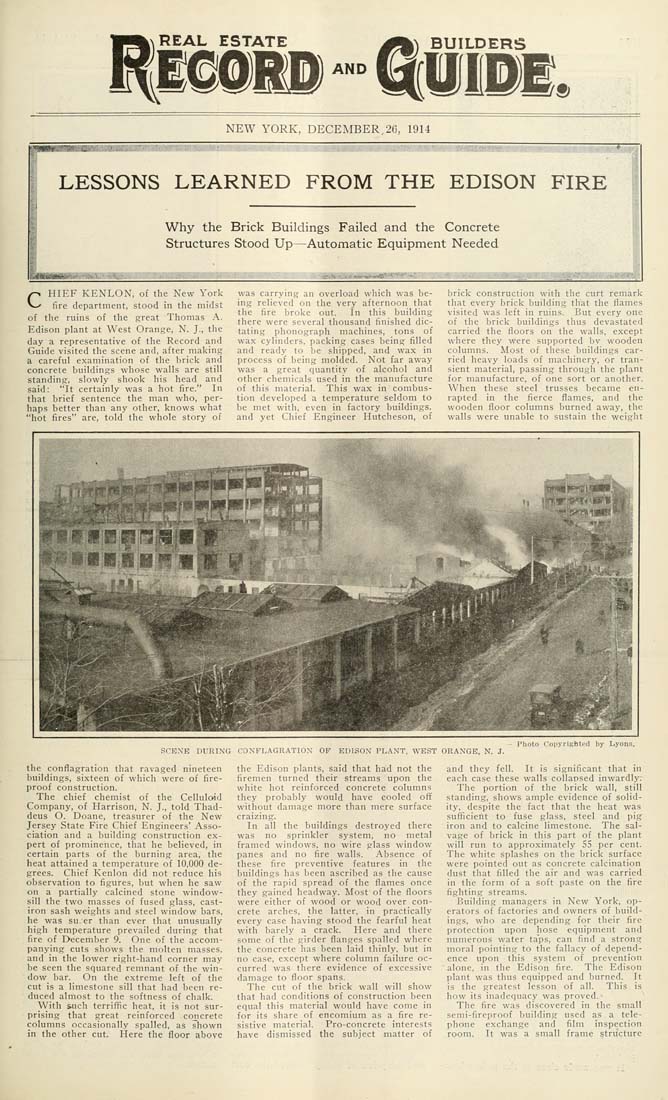Columbia University Libraries Digital Collections: The Real Estate Record
Use your browser's Print function to print these pages.
Real estate record and builders' guide: [v. 94, no. 2441: Articles]: December 26, 1914

Text version:
Please note: this text may be incomplete. For more information about this OCR, view About OCR text.
REAL ESTATE AND NEW YORK, DECEMBER^2G, 1914 LESSONS LEARNED FROM THE EDISON FIRE I I m I Why the Brick BuiMings Failed and the Concrete Structures Stood Up—Automatic Equipment Needed liBieMMiliiW^^ CHIEF KENLON, of the New Vork fire department, stood in the midst of the ruins of the great Thomas A. Edison plant at West Orange, N. J., the day a representative of the Record and Guide visited the scene and, after making a careful examination of the brick and concrete buildings whose walls are still standing, slowly shook his head and said: "It certainly was a hot fire." In that brief sentence the man who, per¬ haps better than any other, knows what "hot fires" are, told the whole story of was carrying an overload which was be¬ ing relieved on the very afternoon that the fire broke out. In this building there were several thousand finished dic¬ tating phonograph machines, tons of wax cylinders, packing cases being filled and ready to ]:ie shipped, and wax in process of being molded. Not far away was a great quantity of alcohol and other chemicals used in the manufacture of this material. This wax in combus¬ tion developed a temperature seldom to be met with, even in factory buildings, and yet Chief Engineer Hutcheson, of brick construction with the curt remark that every brick building that the flames visited was left in ruins. But every one of the brick buildings thus devastated carried the floors on the walls, except where they were supported hv wooden columns. Most of these buildings car¬ ried heavy loads of machinery, or tran¬ sient material, passing through the plant for manufacture, of one sort or another. When these steel trusses became en- rapted in the fierce flames, and the wooden floor columns burned away, the walls were unable to sustain the weight SCENE DURING CONFLAGRATION OF EDISON PLANT, WEST ORANGE. N. J. lighted by Lyons. the conflagration that ravaged nineteen buildings, sixteen of which were of fire¬ proof construction. The chief chemist of the Celluloid Company, of Harrison, N. J., told Thad¬ deus O. Doane, treasurer of the New Jersey State Fire Chief Engineers' Asso¬ ciation and a building construction ex¬ pert of prominence, that he believed, in certain parts of the burning area, the heat attained a temperature of 10,000 de¬ grees. Chief Kenlon did not reduce his observation to figures, but when he saw on a partially calcined stone window- sill the two masses of fused glass, cast- iron sash weights and steel window bars, he was su-er than ever that unusually high temperature prevailed during that fire of December 9. One of the accom¬ panying cuts shows the molten masses. and in the lower right-hand corner may be seen the squared remnant of the win¬ dow bar. On the extreme left of the cut is a limestone sill that had been re¬ duced almost to the softness of chalk. With such terriffic heat, it is not sur¬ prising that great reinforced cojicrete columns occasionally spalled. as shown in the other cut. Here the floor above the Edison plants, said that had not the firemen turned their streams upon the white hot reinforced concrete columns they probably would have cooled oft without damage more than mere surface craizing. In all the buildings destroyed there was no sprinkler system, no metal framed windows, no wire glass window panes and no fire walls. Absence of these fire preventive features in the buildings has been ascribed as the cause of the rapid spread of the flames once they gained headway. Most of the floors were either of wood or wood over con¬ crete arches, the latter, in practically every case having stood the fearful lieat with barely a crack. Here and there some of the girder flanges spalled where the concrete has been laid thinly, but in no case, except where column failure oc¬ curred was there evidence of excessive damage to floor spans. The cut of the brick wall will show that had conditions of construction been equal this material would have come in for its share of encomium as a fire re¬ sistive material. Pro-concrete interests have dismissed the subject matter of and they fell. It is significant that in each case these walls collapsed inwardly: The portion of the brick wall, still standing, shows ample evidence of solid¬ ity, despite the fact that the heat was sufficient to fuse glass, steel and pig iron and to calcine limestone. The sal¬ vage of brick in this part of the plant will run to approximately 55 per cent. The white splashes on the brick surface were pointed out as concrete calcination dust that filled the air and was carried in the form of a soft paste on the fire fighting streams. Building managers in New York, op¬ erators of factories and owners of build¬ ings, who are depending for their fire protection upon hose equipment and numerous water ta"ps, can find a strong moral pointing to the fallacy of depend¬ ence upon this system of prevention alone, in the Edison fire. The Edison plant was thus equipped and burned. It is the greatest lesson of all. This is how its inadequacy was proved.'- The fire was discovered in the small semi-fireproof building used as a tele¬ phone exchange and film inspection room. It was a small frame structure